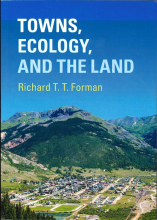You are here
Museum Event to Explore the Ecology of Towns & Villages

On Tuesday, September 17, Richard Forman, a renowned landscape ecologist and long-time research collaborator of the Harvard Forest, will present his new book on the ecology of towns and villages in a free public lecture in the Fisher Museum, beginning at 7:00 p.m. Those who can't attend this talk in person can catch the live-stream of Forman's Sept. 20 seminar on the same topic (at 11:00am ET).
Most of what is known about the natural world has been learned by scientists studying remote ecosystems, far from the confounding bustle of cities. Cities are now defined as ecosystems, too, and many scientists - including ecologists at Harvard Forest - study urban landscapes to understand the physical, biological, human dynamics that make cities tick. But nearly half of the earth’s land surface is neither rural nor urban, escaping the eye of ecologists—until recently. Harvard professor emeritus Richard Forman, widely considered a father of the field of landscape ecology, has written a book exploring the unique ecology of towns and villages.
Forman’s new book, Towns, Ecology, and the Land (Cambridge University Press), describes towns and villages as important, dynamic environmental hotspots. Speaking ecologically, “towns are not just small cities,” says Forman. Unlike cities, they often preserve rather than bury their streams, he says, and they exude far less heat. He notes the unique dynamics of wildlife: at edges, you see a “rain of species” from surrounding rural areas—drawn by scattered bright lights, ample water, and diverse plant life.
Forman has analyzed towns and villages the world over, and still considers New England unique. In our region, glacial silt and sand made widespread colonial agriculture possible, but today many of those towns are transformed by rich forests. Despite differences in history, though, common characteristics emerge in small towns across the globe, such as orchards, fields, small family forests, and livestock in close proximity to houses. Trails radiate through the land, small-scale irrigation is common, and bird feeders attract forest birds (and bears). There are downsides, too: dogs and cats degrade wildlife habitat or populations, road salt pollutes wells.
Although simply understanding the land of towns and villages was Forman’s goal for the book, he has included ideas for making better towns, and better land. Imagine widespread solar panels on buildings, he says, and busy town centers with rich vegetation, strategic wildlife crossings, less flooding (even in extreme storms), and no traffic.
“Opening the town ecology frontier catalyzes research for both nature and us,” says Forman. With a better understanding of how these landscapes function and change over time, he suggests, residents and professionals can step forward to mold better towns for the future.
Forman will sign books at the conclusion of the event. Light refreshments will be served. Please direct questions about the event to Clarisse Hart, 978-756-6157, hart3@fas.harvard.edu.
- Learn more about the book.
- Read Forman's August 2019 editorial about the topic in the journal Landscape Ecology.
- Learn more about regional landscape studies at Harvard Forest.

